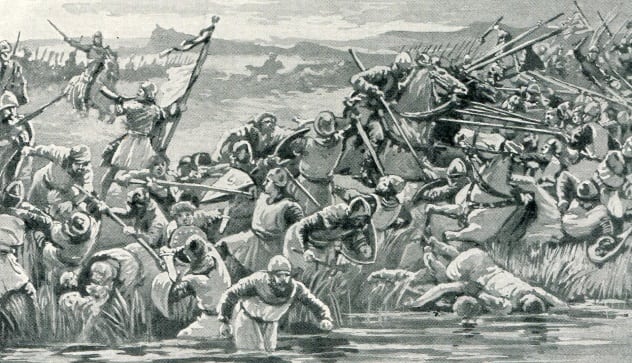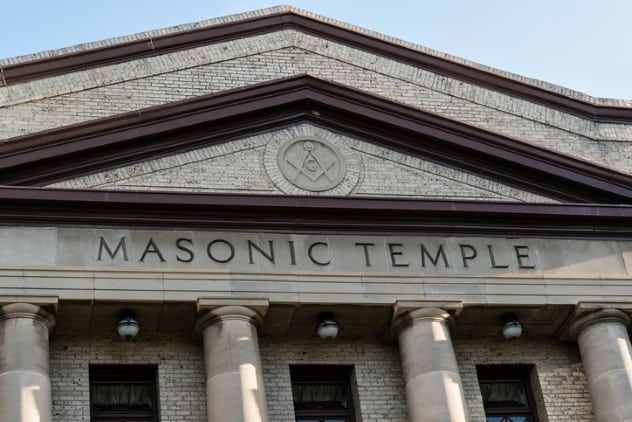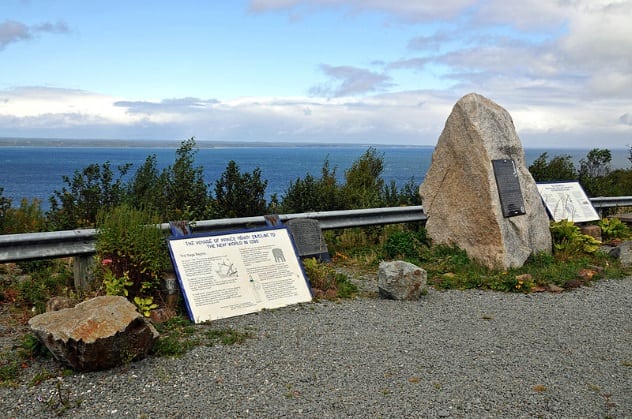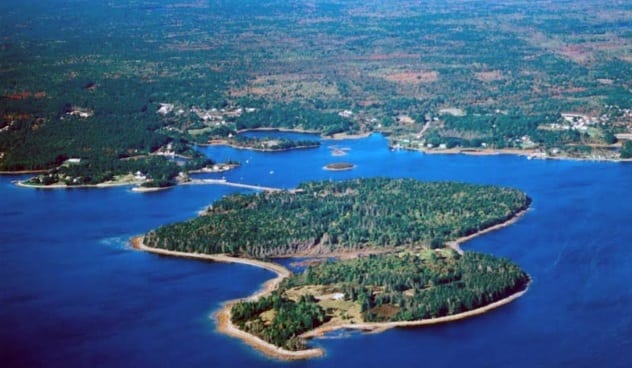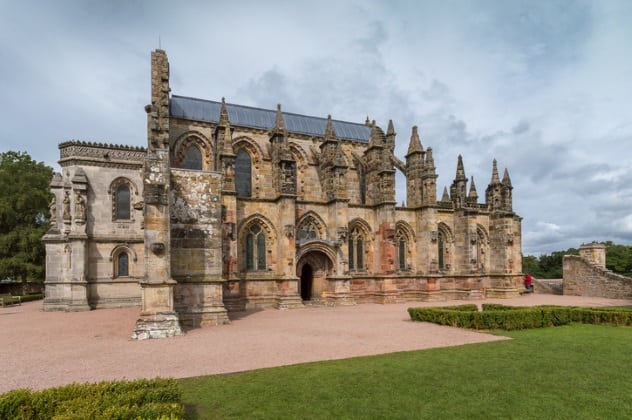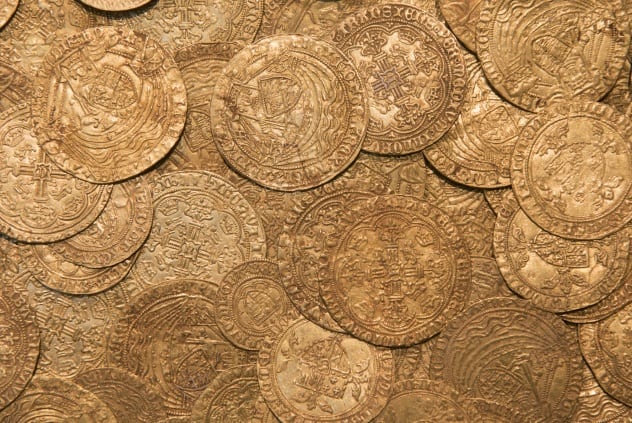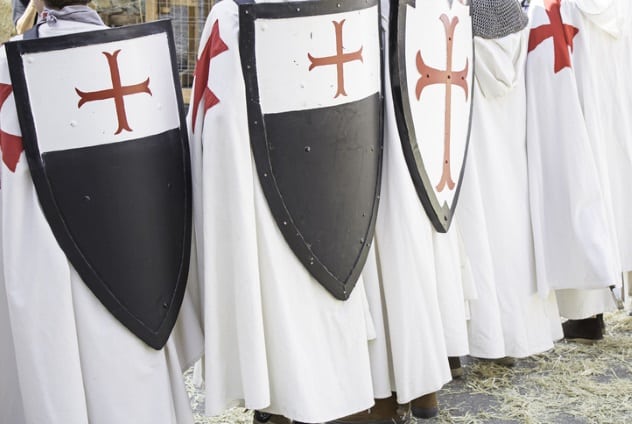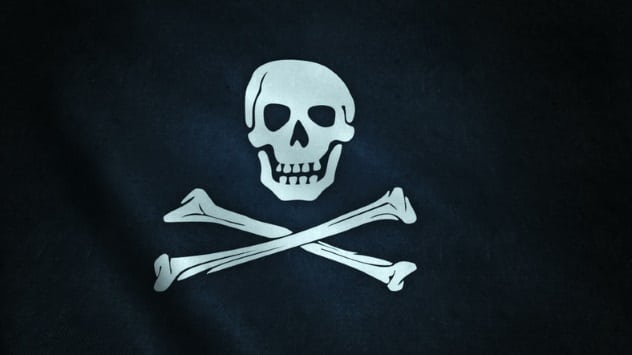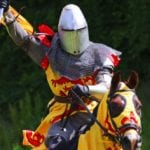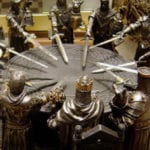The influence of the Knights Templar in history is undeniable. What’s more, to some, that influence is still felt today. Here are ten intriguing points of interest concerning one of the most powerful and respected organizations on record, and one whose true history continues to be studied today.
10 The Surprise At The Battle Of Bannockburn
In the summer of 1314, a small, exhausted, and pieced together (but effective) resistance inflicted one of the most shocking defeats on one of the best armies in English history. The Scots were outnumbered at least two-to-one (some put those figures as high as five-to-one), and their victory, at least on paper, just shouldn’t have happened. The English should have defeated the Scots with ease. Despite their recent victories, the Scots were now severely outnumbered and were starting to succumb to the grind of such battles. The engagement ended, however, with the English army retreating in a panic, with the men trampling each other to death trying to escape. Only the Knights Templar were so feared at the time, and given the connections they already had to Robert the Bruce through the Sinclair family (who themselves had entered England and then in turn Scotland from France with William the Conqueror in 1066), it makes sense to think they would come to the aide of their friend and ally when required. Indeed, it has been claimed that many Templars came to Scotland during the years prior to the battle, and their presence tipped the scales.[1]
9 Did The Knights Templar Become The Freemasons?
Following the orders for their arrest by King Philip IV of France, combined with the various “inquisitions” of the time, the Knights Templar would find ultimately begin finding sanctuary in Scotland from 1307 onward.[2] Scotland was one of the few places offering them safety, with Portugal being the other. This is partly the reason for the Templars having such large numbers in Scotland at the time of the battles between the Scots and England. Following the aforementioned Battle of Bannockburn, it is said that Robert the Bruce established the very first Scottish Masonic lodge, which, in reality, was a beacon to other Knights Templar also seeking sanctuary. While Robert himself was a member of this lodge (essentially making him one of the first “Freemasons”), so were key members of the Sinclair family, who had fought alongside Robert against the English in several key battles before the famous one at Bannockburn. The Sinclairs were—and still are—an influential family line. Aside from their contributions to the Masons (and the Templars before that), as we will look at over our next entries, they were also important contributors to many mysteries still pondered today.
8 Did Henry Sinclair Travel To America A Century Before Columbus?
While Christopher Columbus sailed to America in 1492, it has been claimed that Henry Sinclair (grandfather to William Sinclair, who would build Rosslyn Chapel) set foot in the New World nearly a century earlier in 1398.[3] He supposedly originally landed in Nova Scotia before moving down into the area we call New England today. (The alleged landing site even has a monument commemorating Sinclair’s voyage.) There is supposedly plenty of evidence of a Templar presence in North America, too. In addition to several graves and remains purportedly of named and recorded Templar knights on the upper East Coast of the US, Newport Tower in Rhode Island is said to be unmistakably a Templar design. To some, it is quite simply their calling card, preserved in stone for all to see. It is thought that Sinclair (and other Templars) were aware of the land that would be called the United States several centuries later by using maps that had been handed down through generations going back to the time of the Library of Alexandria. It is also said by some researchers of Templar history that Sinclair wished to build a new land where a person could practice any religion of their choosing, as well as indulge in science and art without fear of persecution from the Church. Although he would ultimately die before beginning such a colony, those sentiments are extremely similar to the ones expressed by the eventual Founding Fathers of the United States, who we also know had a genuine connection to Masonic lodges of the time.
7 The Mystery Of Oak Island
When the Templars emptied their “vaults” of their treasures upon the advance warning of King Philip’s betrayal of them, most researchers agree it was hauled onto the many ships that they owned, which then set sail into the Mediterranean and ultimately out into the Atlantic. From there, opinions and theories differ as to where the treasure went. Some believe Portugal offered safe enough sanctuary, while others point to Scotland. Still others believe the Templars sailed the seas, with their riches constantly on the move for several decades, if not longer. It could be all of the these, but many believe the vast majority ended up in America, at Oak Island in Nova Scotia.[4] Despite the expenditure of millions upon millions of dollars, nothing of any significance has been found on Oak Island. That is not to say that the treasure isn’t there, however. A series of complicated drainage traps have simply perplexed all who have attempted to enter what many believe to be a vault packed with riches somewhere below the island. One of the other places that reportedly holds the treasures of the Templars—or at least clues as to its location, is the next entry on our list.
6 The ‘Clues’ In Rosslyn Chapel
We have looked at an entire list of crazy conspiracy theories regarding Rosslyn Chapel before, and while some of them are particularly outlandish, there are some genuine mysteries to the small church in the otherwise sleepy, picturesque village of Rosslyn (also spelled Roslin) in Scotland.[5] Many take notice of the content of the chapel’s architecture, particularly the depictions of what some believe to be maize (corn), which is native to America and was not known to the people of Europe (at least officially) until at least half a century after Rosslyn Chapel was built. Perhaps it lends credence to the notion that the Templars did explore North America long before Columbus. Perhaps this is the reason such “messages” and symbols are allegedly hidden in plain sight in the stone. And let’s face it, they work, too. If not for these stone carvings of corn, any assertions of a Templar presence in America might be all too easily dismissed. Also of interest are the empty spaces under the foundations of the church. These are unlikely to be excavated due to safety concerns. While there is most likely nothing of interest down there, the fact that the space remains unexplored keeps such notions alive.
5 Awareness Of The Planets And Ritual
Although it isn’t a theory shared by many (if any) mainstream historians, according to researcher and writer Jeff Nisbet, the Knights Templar were guided by ritual and esoteric knowledge of astronomy and astrology combined. In an article for Atlantis Rising titled “The Mystery Of The Battle Of Bannockburn,” which was reproduced in the book Forbidden Religion, Nisbet drew “parallels” between the battle as it happened and the positions of the constellations and planets at the same time. Writing about the movement and layout of the constellations at this time in history, Nisbet states: As dawn, Taurus the bull stands on the horizon, facing north in a sky already too bright to see him. The uppermost stars of Orion the Hunter have just risen. Venus, a planet long associated with the pre-Christian Goddess, shines just north of Orion’s weapon, in a direct line with the bull’s lower horn. The Sun rises in Gemini, the heavenly twins, followed by Jupiter, Mercury, and the Moon. Bringing up the rear is Leo the lion, with the war planet Mars below its breast. Accompanying Orion are his two hunting companions, Canis Major and Canis Minor, the Big Dog and the Little Dog. He then goes on to state how this relates to the activities of the day: First, an event at midday that becomes the single most memorable of the entire two-day engagement: first blood. Due to a leadership dispute, Edward’s army is split into two great horns as it thunders near. Earl Gilbert de Clare of Gloucester commands one horn. Earl Humphrey de Bohun of Hereford commands the other. Some fifty yards ahead of Hereford’s column rides his nephew, Henry de Bohun, clad in full armor, on a powerful warhorse, with his spear in his hand. Henry spots the king of Scots, armed only with a battle-ax and shield, sitting on a small grey horse, inspecting some of his troops at the forest’s edge. De Bohun sees the chance to singlehandedly win the battle before it begins and takes the shot. He couches his lance and charges, full-tilt, toward Robert, but Robert is ready. A split second before Henry’s lance can pierce him through, Robert sidesteps his horse, and standing in his stirrups, delivers Henry a mighty blow that cuts through his helmet, skull, and brain. It is a tidy tale stirring enough to survive down through time, as was perhaps intended.[6] It is certainly a wild theory, but given the Templars’ study of esoteric knowledge, it’s perhaps not as outrageous as some might think.
4 They Were The Banks (Before The Banks)
Although the Christian religion at that time banned usury (adding interest on loans), the Knights Templar were, for all intents and purposes, the banks of their era and certainly set a rough blueprint for the banking systems of the modern world.[7] They would often lend small amounts to citizens and would also fund the war efforts and crusades of royal houses throughout Europe. Incidentally, one of their clients was King Philip IV, who would eventually order the arrest and execution of many Templars, in part because of the vast amount of debt he had built up, no doubt. As they were a charity and pledged poverty, anyone wishing to join the Templars’ ranks (and plenty of young men did) would usually pledge money, treasures, or even the ownership of land to them. Many other well-wishers would make donations to their cause, which, although in much more modest amounts, were still substantial in themselves. This vast and quickly assembled amount of riches, which would include any treasures the Templars found on the Crusades and other such “missions” of the church, were stored in huge vaults in Paris and London. Also, because of their “wealth,” they were usually the most influential force in any country they had a presence in.
3 The Ultimate Secret: The Divinity Of John The Baptist
One of the legends that consistently arises concerning the Knights Templar was their worship of John the Baptist, who some say they believed was the true lord and deity. According to some researchers, they found John’s head under the Temple Mount in the 12th century, and this is what caused the Templars to pack their possessions and treasures into five large caskets and leave Jerusalem immediately. Many believe the Knights Templar also carried the head of John the Baptist with them and would, on occasion, pray to the grisly remains.[8] According to Templar legends, being in the presence of such a divine object (albeit a head in this case) allowed those around it to absorb the divinity and the energy of the person. Even having one of the holy person’s possessions or items of clothing could also achieve this. A possible point of interest here is the secret society known as Skull and Bones, of which former US presidents Bush Sr. and Jr. are both members. Aside from the name (which has possible Templar connections which we will look at in our last entry), they, if the gruesome stories are to be believed, have the head of Geronimo in their secret headquarters as well as the silverware of Adolf Hitler. While there are no rumors of the group holding either of these two people in divine status, perhaps the energy they wish to absorb from such powerful individuals is the reason behind the holding of such grim possessions.
2 Did They Start With Only Nine Members?
Although some dispute this version of Knights Templar history, it is said that their numbers began with nine original members, with Hugues de Payens largely agreed upon as being “the” founding member.[9] Their loyalty was sworn to Christ (although as we mentioned in our above point, that is debatable to some), and their mission was to protect Christians on pilgrimage to the Holy Land. Incidentally, again while it is purely speculation, some believe the Templar knights’ real concern was not so much the pilgrims but the treasure they expected to find at the Temple Mount. What is interesting here is the esoteric and ancient mysticism that the number nine holds, particularly if we accept that the Knights Templar, like the Freemasons, had such an interest. For example, the Aztecs worshiped the Nine Lords of the Night, and even the ancient Egyptians believed in the Ennead, a group of nine gods who formed the tribunal in the Osiris myth.
1 The Origins Of The Jolly Roger
Most of us today associate the black flag with the skull and crossbones on it with pirates. However, the links between the Jolly Roger and the Knights Templar, whose flag it was in reality, are intriguing, to say the least.[10] Following their banishing and hunting down by King Philip, the Templar knights (those who didn’t find refuge elsewhere) would take to the seas. They used the flag of the skull and crossbones as their own, for those in the know, as they could no longer fly their white flag with the red cross openly. It is from here that the association with “nasty pirates” comes from. In reality, the Knights Templar, under the Jolly Roger flag, would only attack ships of the Vatican and royal ships which were not favorable to their cause. In many ways, the ships flying the skull-and-crossbones flag were the military navy of the Templars, a navy that didn’t officially exist and a secretive unit that was likely responsible for some of the mysterious maps that have surfaced just as mysteriously from time to time. Read More: Twitter Facebook Me Time For The Mind
